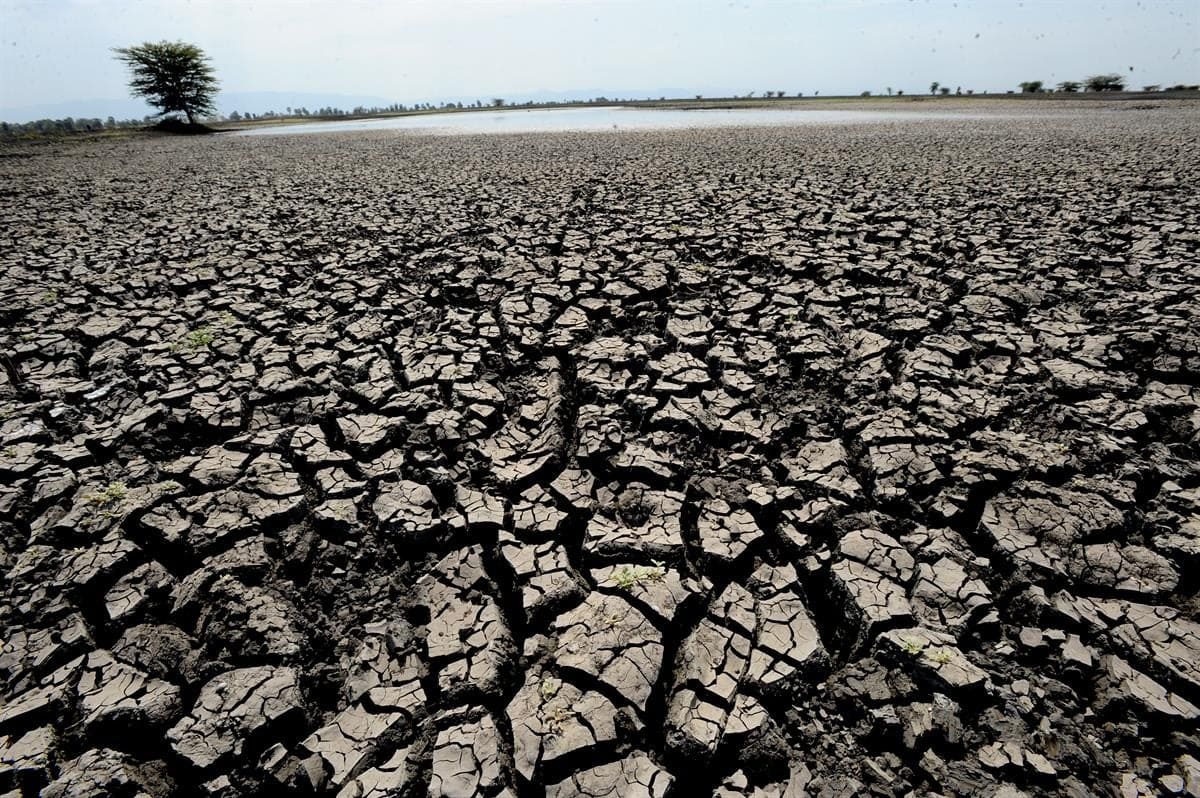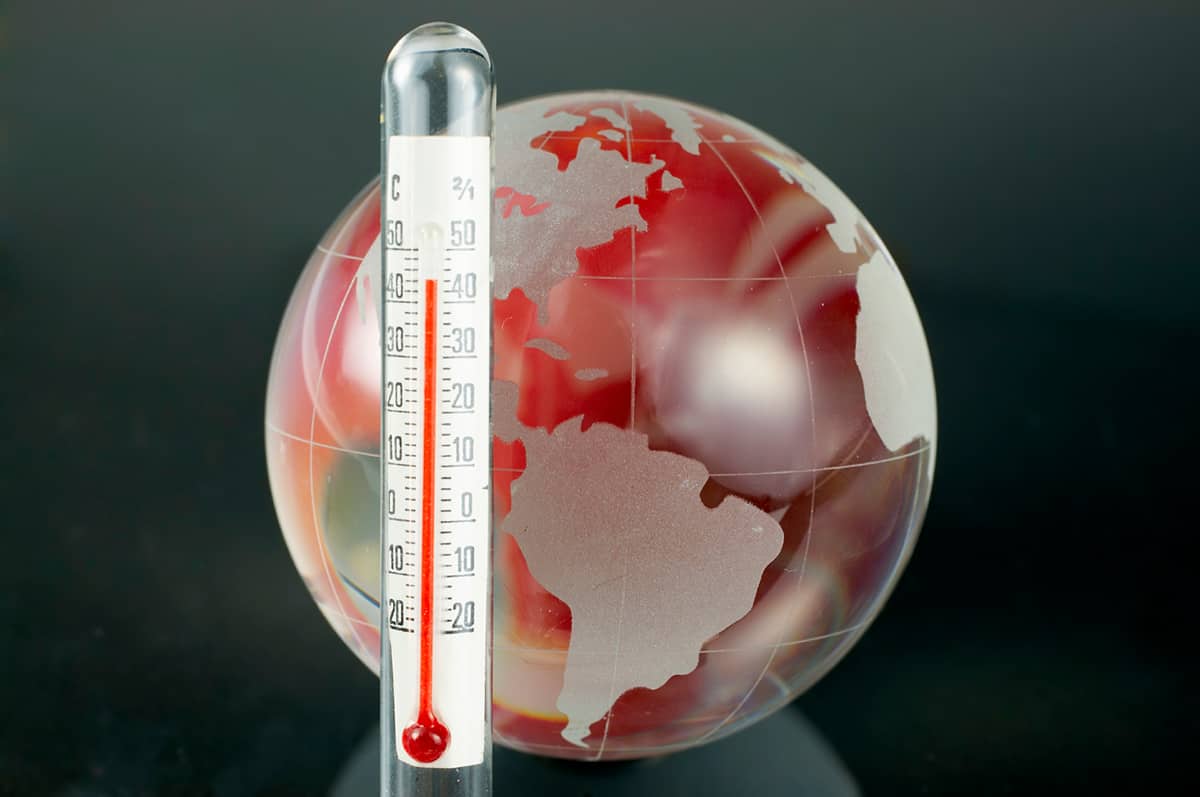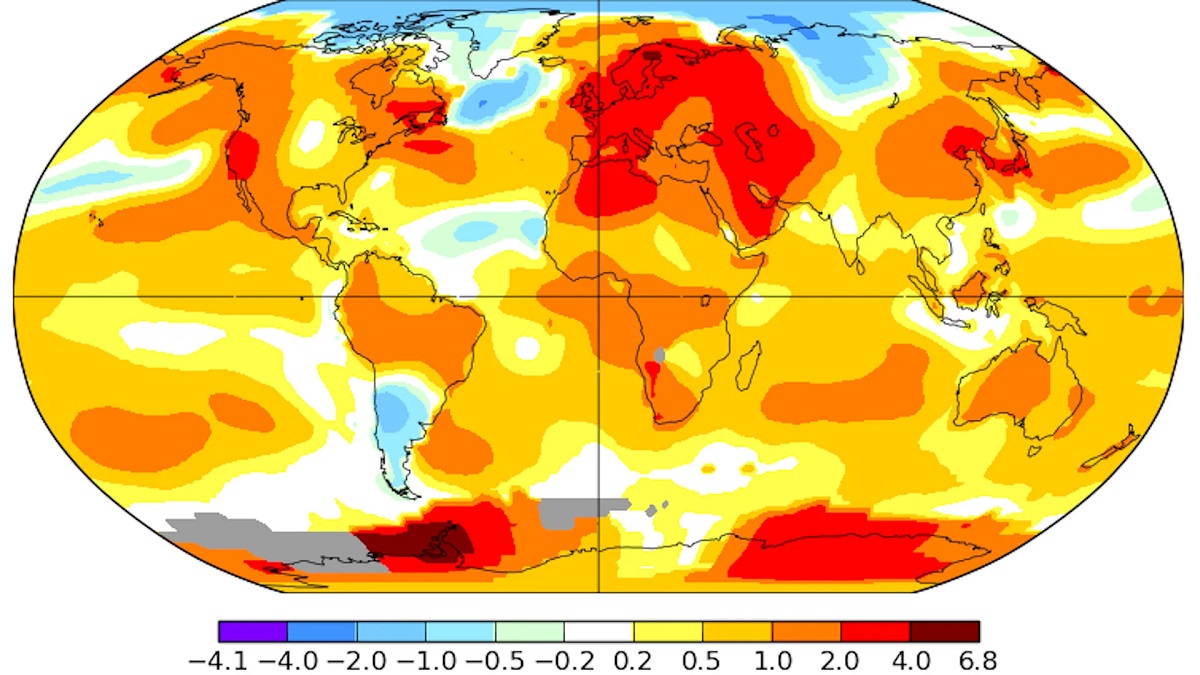Home>Science & Environment>Key Climate Change Statistics And Data: Understanding The Impact And Trends


Science & Environment
Key Climate Change Statistics And Data: Understanding The Impact And Trends
Modified: March 6, 2024
Discover key climate change statistics and data, and gain insights into the impact and trends. Explore the latest findings in science and environment.
(Many of the links in this article redirect to a specific reviewed product. Your purchase of these products through affiliate links helps to generate commission for Temperatures.com, at no extra cost. Learn more)
Table of Contents
Introduction
Climate change is a pressing global issue that has garnered significant attention in recent years. The Earth's climate is undergoing profound changes, primarily due to human activities that have led to an increase in greenhouse gas emissions. These changes are impacting various aspects of the environment, including temperature patterns, sea levels, weather events, and ecosystems. Understanding the key statistics and data related to climate change is crucial in comprehending the magnitude of its impact and the urgency of addressing this issue.
As we delve into the statistics and data surrounding climate change, it becomes evident that the planet is experiencing unprecedented shifts in temperature. This is reflected in the rising global average temperatures, which have increased significantly over the past century. The implications of this trend extend beyond mere numbers, as it directly influences weather patterns, sea levels, and the overall stability of ecosystems.
Moreover, the rise in global temperatures has contributed to the accelerated melting of polar ice caps and glaciers, leading to a substantial increase in sea levels. This phenomenon poses a significant threat to coastal regions and low-lying areas, potentially displacing millions of people and causing widespread environmental and socioeconomic repercussions.
In addition to rising sea levels, climate change has also been linked to an increase in extreme weather events, such as hurricanes, heatwaves, and intense rainfall. These events have become more frequent and severe, posing a direct threat to human lives, infrastructure, and agricultural systems.
The statistics related to carbon dioxide emissions further underscore the gravity of the situation. Human activities, including the burning of fossil fuels and deforestation, have significantly elevated the levels of carbon dioxide in the atmosphere. This has led to a heightened greenhouse effect, trapping heat and exacerbating global warming.
The impact of climate change extends beyond the environment, affecting human health and economic stability. From the spread of vector-borne diseases to disruptions in food production and water resources, the consequences of climate change are far-reaching and multifaceted.
Understanding these key climate change statistics and data is pivotal in fostering a collective sense of urgency and responsibility. By comprehending the magnitude of the issue, individuals, communities, and policymakers can work towards implementing effective mitigation strategies and policies to address climate change and safeguard the planet for future generations.
Global Temperature Trends
The analysis of global temperature trends provides compelling evidence of the significant impact of climate change. Over the past century, the Earth's average surface temperature has exhibited a notable upward trajectory, reflecting a clear pattern of global warming. This trend is substantiated by comprehensive data collected through various scientific methods, including direct temperature measurements, satellite observations, and paleoclimate records.
According to the National Aeronautics and Space Administration (NASA) and the National Oceanic and Atmospheric Administration (NOAA), the 20 warmest years on record have all occurred since 1998, with the exception of 1998, which was an unusually warm year due to a strong El Niño event. This trend underscores the sustained and unprecedented nature of global warming, highlighting the urgency of addressing climate change.
Furthermore, the Intergovernmental Panel on Climate Change (IPCC) has reported that the global average surface temperature has increased by approximately 1.1 degrees Celsius since the pre-industrial era. While this may seem like a modest rise, it has far-reaching implications for the planet's climate systems, ecosystems, and human societies.
The consequences of rising temperatures are evident in various regions across the globe. From the accelerated melting of polar ice caps and glaciers to shifts in precipitation patterns and the frequency of extreme weather events, the impact of global warming is multifaceted and pervasive. These changes have profound implications for the environment, including disruptions in ecosystems, changes in agricultural productivity, and alterations in the distribution of plant and animal species.
Moreover, the warming of the oceans has led to coral bleaching, affecting marine biodiversity and the livelihoods of communities dependent on coastal resources. The implications of rising temperatures extend beyond environmental concerns, encompassing socioeconomic and geopolitical ramifications.
Understanding the trajectory of global temperature trends is crucial in informing climate action and policy formulation. By acknowledging the empirical data and scientific consensus on global warming, stakeholders can work towards implementing mitigation measures, transitioning to renewable energy sources, and fostering sustainable practices to curb further temperature increases.
In essence, the statistics and data pertaining to global temperature trends serve as a clarion call for concerted efforts to address climate change. By recognizing the magnitude of this phenomenon and its implications, societies can strive towards a sustainable and resilient future, mitigating the adverse effects of global warming and preserving the integrity of the planet's ecosystems.
Sea Level Rise
The phenomenon of sea level rise stands as a poignant indicator of the far-reaching impact of climate change on the Earth's geophysical systems. Over the past century, the global mean sea level has experienced a discernible increase, primarily attributed to the thermal expansion of seawater and the melting of polar ice caps and glaciers. This trend is underscored by comprehensive data collected through satellite altimetry, tide gauge measurements, and paleoclimate records, providing unequivocal evidence of the profound alterations occurring in the Earth's oceans.
According to the Intergovernmental Panel on Climate Change (IPCC), the global mean sea level rose by approximately 15 centimeters during the 20th century, with the rate of increase accelerating in recent decades. Moreover, satellite observations have revealed that the rate of sea level rise has nearly doubled from the 20th century to the present day, signaling a concerning trajectory with significant implications for coastal regions and low-lying areas.
The consequences of rising sea levels are multifaceted and pose a substantial threat to coastal communities, infrastructure, and ecosystems. Low-lying coastal areas, including small island nations and densely populated coastal cities, are particularly vulnerable to the encroaching waters. The increased frequency and intensity of coastal flooding, storm surges, and saltwater intrusion have the potential to displace millions of people and exacerbate socioeconomic disparities.
Furthermore, the implications of sea level rise extend beyond immediate coastal regions, influencing groundwater salinization, coastal erosion, and the integrity of vital ecosystems such as mangroves, estuaries, and coral reefs. These changes have profound ramifications for biodiversity, fisheries, and the overall resilience of coastal ecosystems, impacting the livelihoods of communities reliant on coastal resources.
The statistics and data pertaining to sea level rise serve as a sobering reminder of the urgent need to address climate change and implement adaptation measures to mitigate the impact on vulnerable coastal regions. By fostering a deeper understanding of the magnitude of sea level rise and its repercussions, societies and policymakers can work towards developing resilient coastal infrastructure, enhancing early warning systems, and implementing sustainable coastal management practices to safeguard the well-being of coastal communities and the integrity of coastal ecosystems.
In essence, the statistics and data related to sea level rise underscore the imperative of collective action to address climate change and its consequences, particularly in vulnerable coastal regions. By acknowledging the empirical evidence and scientific consensus on sea level rise, stakeholders can strive towards implementing adaptive strategies and fostering resilience in the face of this formidable environmental challenge.
Extreme Weather Events
Extreme weather events, including hurricanes, heatwaves, droughts, and intense rainfall, have become increasingly prevalent and severe in the context of climate change. The statistics and data pertaining to these events provide compelling evidence of their escalating frequency and impact on human societies, infrastructure, and ecosystems.
According to the Intergovernmental Panel on Climate Change (IPCC), the incidence of extreme weather events has exhibited a discernible upward trend, with a notable increase in the frequency of intense tropical cyclones and heatwaves in various regions across the globe. This trend is substantiated by comprehensive meteorological records and satellite observations, which highlight the heightened vulnerability of communities to the ravages of extreme weather.
In recent years, hurricanes and typhoons have unleashed unprecedented devastation, causing widespread destruction to coastal areas and posing significant threats to human lives and livelihoods. The intensification of these tropical storms can be attributed to the warming of ocean waters, providing a conducive environment for the development of powerful and destructive weather systems.
Moreover, heatwaves have become more frequent and prolonged, exposing populations to hazardous heat stress and exacerbating the risk of heat-related illnesses. The statistics reveal a concerning pattern of rising temperatures and prolonged heatwave durations, underscoring the urgency of implementing measures to protect vulnerable populations, particularly the elderly and those with pre-existing health conditions.
In addition to hurricanes and heatwaves, the incidence of intense rainfall and flooding events has surged, leading to widespread inundation, infrastructure damage, and disruptions to essential services. The data on precipitation patterns and flood occurrences emphasize the escalating risks posed by extreme rainfall, particularly in urban areas with inadequate drainage systems and flood defenses.
The implications of these extreme weather events extend beyond immediate physical damage, encompassing long-term socio-economic repercussions and challenges in disaster recovery and resilience-building. The statistics and data serve as a stark reminder of the imperative to bolster adaptive capacities, enhance early warning systems, and invest in resilient infrastructure to mitigate the impact of extreme weather events on human societies and ecosystems.
In essence, the statistics and data related to extreme weather events underscore the urgency of proactive measures to address climate change and its consequences. By acknowledging the empirical evidence and scientific consensus on the escalating frequency and severity of extreme weather events, stakeholders can work towards implementing adaptive strategies and fostering resilience in the face of these formidable environmental challenges.
Carbon Dioxide Emissions
Carbon dioxide (CO2) emissions are a pivotal aspect of the climate change discourse, representing a significant contributor to the heightened greenhouse effect and global warming. The statistics and data pertaining to CO2 emissions offer profound insights into the scale of human activities' impact on the Earth's atmosphere and the urgency of mitigating these emissions to curb the progression of climate change.
Over the past century, human activities, including the burning of fossil fuels, industrial processes, and deforestation, have led to a substantial increase in CO2 emissions. The combustion of fossil fuels, such as coal, oil, and natural gas, for energy production and transportation, stands as a primary source of anthropogenic CO2 emissions. Additionally, land-use changes, particularly deforestation and land clearing for agricultural expansion, have contributed significantly to CO2 emissions, disrupting the natural carbon cycle and exacerbating the greenhouse effect.
The comprehensive data on CO2 emissions underscore the magnitude of this environmental challenge. According to the Global Carbon Project, global CO2 emissions from fossil fuel combustion and industrial processes reached a record high of 36.8 billion metric tons in 2019, reflecting a concerning trajectory of unabated emissions. This trend is further compounded by the release of CO2 from land-use changes, amplifying the overall impact on the Earth's climate systems.
The implications of escalating CO2 emissions are far-reaching, influencing not only global temperature patterns but also ocean acidification, air quality, and the integrity of ecosystems. The accumulation of CO2 in the atmosphere has led to a heightened greenhouse effect, trapping heat and resulting in global warming. Moreover, the absorption of CO2 by the oceans has led to ocean acidification, posing a significant threat to marine biodiversity and the livelihoods of communities dependent on coastal resources.
Understanding the statistics and data related to CO2 emissions is pivotal in fostering a collective sense of responsibility and urgency in addressing this critical issue. By acknowledging the empirical evidence and scientific consensus on the scale of CO2 emissions and their impact, societies and policymakers can work towards implementing effective mitigation strategies, transitioning to renewable energy sources, and fostering sustainable practices to curb further emissions.
In essence, the statistics and data on CO2 emissions serve as a clarion call for concerted efforts to address climate change. By recognizing the magnitude of this phenomenon and its implications, stakeholders can strive towards a sustainable and resilient future, mitigating the adverse effects of escalating CO2 emissions and preserving the integrity of the Earth's ecosystems.
Impact on Ecosystems
The impact of climate change on ecosystems is profound and multifaceted, encompassing a wide array of ecological disruptions that have far-reaching implications for biodiversity, ecosystem services, and the overall stability of natural systems. The statistics and data pertaining to this impact provide compelling evidence of the escalating threats posed to terrestrial, freshwater, and marine ecosystems, underscoring the urgent need to address climate change and its repercussions.
One of the most notable consequences of climate change on ecosystems is the alteration of species distributions and phenology. As temperatures shift and precipitation patterns change, many plant and animal species are compelled to adapt by migrating to more suitable habitats or adjusting their life cycle events, such as flowering, breeding, and migration. The statistics reveal a discernible trend of range shifts and phenological mismatches, disrupting the intricate ecological interactions and leading to potential mismatches between species and their critical resources.
Furthermore, the warming of the oceans and the acidification of marine environments have profound implications for marine ecosystems. Coral reefs, often referred to as the "rainforests of the sea," are particularly vulnerable to the dual threats of ocean warming and acidification. The statistics on coral bleaching events and the decline of reef ecosystems underscore the escalating risks faced by these vital marine habitats, which support unparalleled biodiversity and provide essential ecosystem services to coastal communities.
In addition to terrestrial and marine ecosystems, freshwater ecosystems, including rivers, lakes, and wetlands, are also significantly impacted by climate change. Alterations in precipitation patterns and the intensification of droughts can lead to shifts in hydrological regimes, affecting the availability of water resources and the integrity of freshwater habitats. The statistics on changes in river flow, lake levels, and wetland extent provide compelling evidence of the vulnerability of these ecosystems to the vagaries of climate change, posing significant challenges for aquatic biodiversity and the provision of freshwater services.
The implications of climate change on ecosystems extend beyond ecological disruptions, encompassing socio-economic ramifications and challenges in conservation and natural resource management. The statistics and data serve as a stark reminder of the imperative to bolster adaptive capacities, enhance ecosystem resilience, and implement sustainable management practices to mitigate the impact of climate change on ecosystems.
In essence, the statistics and data related to the impact of climate change on ecosystems underscore the urgency of proactive measures to address this critical issue. By acknowledging the empirical evidence and scientific consensus on the escalating threats to ecosystems, stakeholders can work towards implementing adaptive strategies and fostering resilience in the face of these formidable environmental challenges.
Effects on Human Health
The effects of climate change on human health are profound and multifaceted, encompassing a wide range of direct and indirect impacts that pose significant challenges to public health systems and the well-being of communities worldwide. From the exacerbation of heat-related illnesses to the spread of vector-borne diseases and the disruption of food and water security, the statistics and data pertaining to the effects of climate change on human health provide compelling evidence of the escalating risks faced by populations globally.
One of the most immediate and pervasive consequences of climate change on human health is the heightened risk of heat-related illnesses. As global temperatures rise, particularly in urban areas, the incidence of heatwaves and prolonged periods of extreme heat has surged, exposing populations to hazardous heat stress and increasing the risk of heat-related illnesses, such as heat exhaustion and heatstroke. The statistics on hospital admissions and mortality rates during heatwaves underscore the urgency of implementing measures to protect vulnerable populations, particularly the elderly, children, and individuals with pre-existing health conditions.
Moreover, the changing climate patterns have significant implications for the spread of vector-borne diseases, such as malaria, dengue fever, and Lyme disease. The statistics on the expansion of disease vectors' geographical ranges and the incidence of vector-borne illnesses in previously unaffected regions highlight the escalating risks posed by climate change. Alterations in temperature and precipitation patterns can create conducive environments for disease-carrying vectors, amplifying the transmission of these diseases and posing significant challenges to public health systems.
In addition to the direct health impacts, climate change also influences food and water security, with profound implications for nutrition and waterborne illnesses. Changes in precipitation patterns and the intensification of extreme weather events can lead to disruptions in agricultural productivity, affecting food availability and nutritional quality. The statistics on crop yields, food prices, and malnutrition rates underscore the vulnerability of populations, particularly in low-income regions, to the adverse effects of climate change on food security and nutrition.
Furthermore, the integrity of water resources is significantly impacted by climate change, with alterations in precipitation patterns and the increased frequency of droughts posing challenges to water availability and quality. The statistics on waterborne illnesses and access to safe drinking water highlight the escalating risks faced by communities, particularly in regions prone to water scarcity and contamination.
The implications of climate change on human health extend beyond immediate physical health impacts, encompassing long-term socio-economic repercussions and challenges in healthcare provision and resilience-building. The statistics and data serve as a stark reminder of the imperative to bolster adaptive capacities, enhance public health resilience, and implement measures to mitigate the impact of climate change on human health.
In essence, the statistics and data related to the effects of climate change on human health underscore the urgency of proactive measures to address this critical issue. By acknowledging the empirical evidence and scientific consensus on the escalating risks to human health, stakeholders can work towards implementing adaptive strategies and fostering resilience in the face of these formidable health challenges.
Economic Implications
The economic implications of climate change are far-reaching, exerting significant pressures on global economies, industries, and livelihoods. The statistics and data pertaining to these implications provide compelling evidence of the escalating risks and challenges faced by societies and economies worldwide.
One of the most pronounced economic impacts of climate change is the exacerbation of weather-related disasters, including hurricanes, floods, and wildfires. The escalating frequency and severity of these events have led to substantial economic losses, encompassing damage to infrastructure, disruption of supply chains, and the displacement of communities. According to the World Bank, the average annual losses from weather-related disasters have surged to approximately $150 billion, with low and middle-income countries bearing the brunt of these economic burdens.
Moreover, the implications of climate change extend to the agricultural sector, with alterations in precipitation patterns and the intensification of extreme weather events posing significant challenges to food production and agricultural livelihoods. The statistics on crop yield losses, livestock mortality rates, and agricultural income fluctuations underscore the vulnerability of agricultural systems to the vagaries of climate change, particularly in regions reliant on rain-fed agriculture.
Furthermore, the escalating risks posed by climate change have significant implications for insurance markets and financial systems. The increasing frequency of extreme weather events and the associated economic losses have strained insurance mechanisms, leading to higher premiums and reduced coverage in vulnerable regions. Additionally, the potential for climate-related financial risks, including stranded assets and carbon liabilities, has prompted calls for enhanced climate risk disclosure and financial resilience measures.
The implications of climate change on human health also carry substantial economic burdens, encompassing healthcare costs, productivity losses, and the strain on healthcare systems. The statistics on healthcare expenditures, absenteeism rates, and the economic impact of heat-related illnesses underscore the multifaceted challenges faced by economies in addressing the health repercussions of climate change.
In essence, the statistics and data related to the economic implications of climate change underscore the urgency of proactive measures to address this critical issue. By acknowledging the empirical evidence and scientific consensus on the escalating economic risks, stakeholders can work towards implementing adaptive strategies and fostering resilience in the face of these formidable economic challenges.
Policy and Mitigation Efforts
Policy and mitigation efforts play a pivotal role in addressing the multifaceted challenges posed by climate change. Governments, international organizations, and stakeholders worldwide have recognized the imperative of implementing robust policies and mitigation strategies to curb greenhouse gas emissions, foster resilience, and transition towards sustainable practices.
One of the key policy instruments aimed at mitigating climate change is the implementation of carbon pricing mechanisms, including carbon taxes and emissions trading systems. By placing a price on carbon emissions, these mechanisms incentivize industries and businesses to reduce their carbon footprint, invest in clean technologies, and transition towards low-carbon practices. Moreover, revenue generated from carbon pricing can be channeled towards funding climate adaptation and mitigation initiatives, fostering a transition to a low-carbon economy.
In addition to carbon pricing, governments have increasingly focused on setting ambitious emissions reduction targets and implementing regulatory frameworks to enforce these targets. The Paris Agreement, signed by 196 parties, represents a landmark international accord aimed at limiting global temperature rise to well below 2 degrees Celsius. This agreement has galvanized global efforts to enhance climate action, with countries committing to nationally determined contributions and long-term low-emission development strategies.
Furthermore, investment in renewable energy infrastructure and clean technologies has emerged as a cornerstone of mitigation efforts. Governments and private entities are increasingly directing resources towards expanding renewable energy capacity, such as solar, wind, and hydroelectric power, to reduce reliance on fossil fuels and mitigate emissions. Incentive programs, subsidies, and research and development initiatives have been instrumental in driving the deployment of renewable energy technologies, fostering a transition towards a sustainable energy landscape.
Moreover, adaptation measures, including the development of climate-resilient infrastructure, early warning systems, and ecosystem-based approaches, are integral components of policy frameworks aimed at enhancing resilience to climate change impacts. By integrating climate considerations into urban planning, water resource management, and disaster risk reduction strategies, governments can bolster adaptive capacities and minimize the vulnerability of communities and ecosystems to climate-related hazards.
The integration of climate considerations into national policies, development plans, and sectoral strategies is pivotal in mainstreaming climate action across diverse sectors, fostering a holistic approach to addressing climate change. By aligning policies with the objectives of sustainable development, biodiversity conservation, and poverty alleviation, governments can maximize co-benefits and synergies, advancing a comprehensive and inclusive approach to climate mitigation and adaptation.
In essence, policy and mitigation efforts are fundamental in charting a sustainable and resilient path forward in the face of climate change. By fostering international cooperation, enhancing regulatory frameworks, and investing in sustainable technologies and practices, stakeholders can work towards mitigating the impact of climate change and safeguarding the well-being of current and future generations.
Conclusion
In conclusion, the comprehensive analysis of key climate change statistics and data underscores the urgent need for collective action to address this pressing global challenge. The empirical evidence and scientific consensus on global temperature trends, sea level rise, extreme weather events, carbon dioxide emissions, and their multifaceted impacts on ecosystems, human health, and economies provide compelling insights into the scale of the challenge posed by climate change.
The escalating global average temperatures, the discernible rise in sea levels, the increasing frequency and severity of extreme weather events, and the record-high levels of carbon dioxide emissions all point to the imperative of implementing robust policies and mitigation efforts. The statistics on the impact of climate change on ecosystems, human health, and economies further emphasize the far-reaching implications of this phenomenon, necessitating proactive measures to foster resilience and sustainability.
However, amidst the sobering statistics and data, there is also a glimmer of hope. The concerted efforts of governments, international organizations, businesses, and communities in advancing climate action, implementing renewable energy solutions, and integrating climate considerations into policy frameworks signify a collective commitment to addressing climate change. The Paris Agreement, carbon pricing mechanisms, and investments in renewable energy infrastructure exemplify the momentum towards a low-carbon, climate-resilient future.
As we navigate the complexities of climate change, it is imperative to recognize the interconnected nature of this global challenge and the imperative of inclusive, equitable, and science-based solutions. By fostering a deeper understanding of the statistics and data related to climate change, societies and policymakers can work towards implementing adaptive strategies, enhancing resilience, and fostering sustainable practices to mitigate the impact of climate change on ecosystems, human health, and economies.
In essence, the statistics and data on climate change serve as a clarion call for concerted efforts to address this critical issue. By acknowledging the empirical evidence and scientific consensus, stakeholders can strive towards a sustainable and resilient future, mitigating the adverse effects of climate change and preserving the integrity of the planet's ecosystems for current and future generations.













